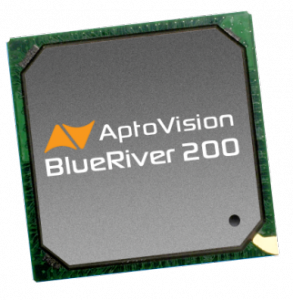In the flurry of activity in the run up to #InfoComm13 in Orlando, one announcement that tickled our technical taste buds was that AptoVision has unveiled their new BlueRiver 200 technology for Ultra-HD video processing and distribution over optical fibre cabling.
 Montreal-based AptoVision has created its new FPGA-based BlueRiver 200 chipset, which is at the cutting edge of multi-media connectivity between AV sources and remote displays. The BlueRiver 200 chipset is the first and only technology in the world, we are told, that is capable of simultaneously transmitting uncompressed Ultra-HD (4K) video, 32 channels of audio, Gigabit Ethernet, 480 Mb/s USB 2.0 and other control signals on a single optical cable at up to 30 KM.
Montreal-based AptoVision has created its new FPGA-based BlueRiver 200 chipset, which is at the cutting edge of multi-media connectivity between AV sources and remote displays. The BlueRiver 200 chipset is the first and only technology in the world, we are told, that is capable of simultaneously transmitting uncompressed Ultra-HD (4K) video, 32 channels of audio, Gigabit Ethernet, 480 Mb/s USB 2.0 and other control signals on a single optical cable at up to 30 KM.
This technology is not for projects for example where you have one player per screen (either next to each other or built-in), but for those where all of the media player infrastructure is centrally located, and signals need to be distributed over longer distances of more than a few metres.
“We are extremely excited to be the first to market with a technology that practically eliminates the bandwidth and distance limitations for all the key signal types used in the AV and KVM industry,” Kamran Ahmed, CEO and co-founder of AptoVision, told us. “With the BlueRiver 200, AptoVision has once again proven that its unique BlueRiver technology and FPGA-based architecture is scalable to accommodate the ever increasing bandwidth requirements of video, Ethernet and USB connectivity.”
Interestingly this isn’t an actual set of products, but rather a licensable technology that manufacturers and integrators can use to build into products, for example KVM extenders or signal matrix switchers.
They have been clever in using standard technology in their designs commonly used in networking applications, like FPGAs and optical transmission over fibre for high bandwidth, but which isn’t so suitable for video signals. Rather than rely on more expensive custom AV components, they’ve created two key methods which overcome the limitations.
Adaptive Clock Resynchronization (ACR) is a way of making sure that video signals are synchronised together, especially necessary when dealing with multiple displays next to each other in videowalls or tiled arrays. ACR achieves this without resorting to the usual method of frame buffering, or delaying the signals at the far end, effectively syncing to the ‘slowest’ signal. This usually results in a noticeable frame delay and other artifacts. ACR gets over this by reconstructing the signal clock as it goes.
BlueRiver Channel Coder combines the multiple signals (ie video, network, USB, audio, etc) into a single channel so that it can use low cost networking optics, rather than use more expensive multi-channel fibre optic components and transmit each signal in a separate channel. This coder is also designed for synchronous video transmission, and does away with the need for frame buffering, keeping the design simpler and cost effective.
Sampling now, the BlueRiver 200 chipset can easily be integrated into OEM designs for AV and KVM extenders, distribution amplifiers and matrix routers. “Ready to manufacture” reference designs for AV extenders based on the BlueRiver 200 chipset are also available.
Smart guys with clever technology for those wanting to build products to keep up with ever increasing signal demands.
About AptoVision
A Privately held company based out of Montreal, AptoVision is redefining the AV signal processing & distribution platform through its ™ technology and FPGA-based chipsets. Integrating unique IP, the BlueRiver™ platform delivers 50% to 80% reduction in system costs & up to 10x performance gains over comparable solutions. The platform also enables the only products in the world which scale with current & evolving AV signal distribution requirements for ultra-high definition & ultra-high bandwidth video, multi-format support, multi-video transmission, & advanced pixel processing.

Follow DailyDOOH